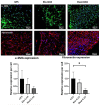Dual Glyoxalase-1 and β-Klotho Gene-Activated Scaffold Reduces Methylglyoxal and Reprograms Diabetic Adipose-Derived Stem Cells: Prospects in Improved Wound Healing
- PMID: 38399319
- PMCID: PMC10892312
- DOI: 10.3390/pharmaceutics16020265
Dual Glyoxalase-1 and β-Klotho Gene-Activated Scaffold Reduces Methylglyoxal and Reprograms Diabetic Adipose-Derived Stem Cells: Prospects in Improved Wound Healing
Abstract
Tissue engineering approaches aim to provide biocompatible scaffold supports that allow healing to progress often in healthy tissue. In diabetic foot ulcers (DFUs), hyperglycemia impedes ulcer regeneration, due to complications involving accumulations of cellular methylglyoxal (MG), a key component of oxidated stress and premature cellular aging which further limits repair. In this study, we aim to reduce MG using a collagen-chondroitin sulfate gene-activated scaffold (GAS) containing the glyoxalase-1 gene (GLO-1) to scavenge MG and anti-fibrotic β-klotho to restore stem cell activity in diabetic adipose-derived stem cells (dADSCs). dADSCs were cultured on dual GAS constructs for 21 days in high-glucose media in vitro. Our results show that dADSCs cultured on dual GAS significantly reduced MG accumulation (-84%; p < 0.05) compared to the gene-free controls. Similar reductions in profibrotic proteins α-smooth muscle actin (-65%) and fibronectin (-76%; p < 0.05) were identified in dual GAS groups. Similar findings were observed in the expression of pro-scarring structural proteins collagen I (-62%), collagen IV (-70%) and collagen VII (-86%). A non-significant decrease in the expression of basement membrane protein E-cadherin (-59%) was noted; however, the dual GAS showed a significant increase in the expression of laminin (+300%). We conclude that dual GAS-containing Glo-1 and β-klotho had a synergistic MG detoxification and anti-fibrotic role in dADSC's. This may be beneficial to provide better wound healing in DFUs by controlling the diabetic environment and rejuvenating the diabetic stem cells towards improved wound healing.
Keywords: adipose-derived stem cells; anti-fibrotic; gene-activated scaffold; glyoxalase-1; matrix deposition; methylglyoxal; stem cells rejuvenation; wound healing; β-klotho.
Conflict of interest statement
The authors declare no conflicts of interest.
Figures





Similar articles
-
Anti-Aging β-Klotho Gene-Activated Scaffold Promotes Rejuvenative Wound Healing Response in Human Adipose-Derived Stem Cells.Pharmaceuticals (Basel). 2021 Nov 17;14(11):1168. doi: 10.3390/ph14111168. Pharmaceuticals (Basel). 2021. PMID: 34832950 Free PMC article.
-
Anti-Ageing Protein β-Klotho Rejuvenates Diabetic Stem Cells for Improved Gene-Activated Scaffold Based Wound Healing.J Pers Med. 2020 Dec 22;11(1):4. doi: 10.3390/jpm11010004. J Pers Med. 2020. PMID: 33375065 Free PMC article.
-
SDF-1α Gene-Activated Collagen Scaffold Restores Pro-Angiogenic Wound Healing Features in Human Diabetic Adipose-Derived Stem Cells.Biomedicines. 2021 Feb 6;9(2):160. doi: 10.3390/biomedicines9020160. Biomedicines. 2021. PMID: 33562165 Free PMC article.
-
Strategy for Treatment of Infected Diabetic Foot Ulcers.Acc Chem Res. 2021 Mar 2;54(5):1080-1093. doi: 10.1021/acs.accounts.0c00864. Epub 2021 Feb 17. Acc Chem Res. 2021. PMID: 33596041 Review.
-
Recent Advances in Polymer-based Wound Dressings for the Treatment of Diabetic Foot Ulcer: An Overview of State-of-the-art.Curr Drug Targets. 2018;19(5):527-550. doi: 10.2174/1389450118666170704132523. Curr Drug Targets. 2018. PMID: 28676002 Review.
Cited by
-
Targeting senescence to prevent diabetic kidney disease: Exploring molecular mechanisms and potential therapeutic targets for disease management.Diabet Med. 2025 Feb;42(2):e15408. doi: 10.1111/dme.15408. Epub 2024 Jul 12. Diabet Med. 2025. PMID: 38995865 Free PMC article. Review.
-
Glyoxalase 1 gene expression in various types of cancer cells immunopathology: a pan-cancer analysis study.Front Oncol. 2025 Jul 14;15:1610886. doi: 10.3389/fonc.2025.1610886. eCollection 2025. Front Oncol. 2025. PMID: 40727469 Free PMC article.
References
LinkOut - more resources
Full Text Sources
Research Materials
Miscellaneous

